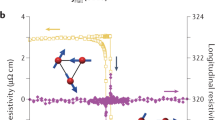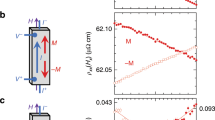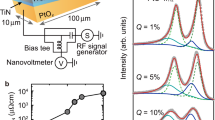Abstract
In ferromagnetic conductors, an electric current may induce a transverse voltage drop in zero applied magnetic field: this anomalous Hall effect1 is observed to be proportional to magnetization, and thus is not usually seen in antiferromagnets in zero field2. Recent developments in theory and experiment have provided a framework for understanding the anomalous Hall effect using Berry-phase concepts3, and this perspective has led to predictions that, under certain conditions, a large anomalous Hall effect may appear in spin liquids and antiferromagnets without net spin magnetization4,5,6,7,8. Although such a spontaneous Hall effect has now been observed in a spin liquid state9, a zero-field anomalous Hall effect has hitherto not been reported for antiferromagnets. Here we report empirical evidence for a large anomalous Hall effect in an antiferromagnet that has vanishingly small magnetization. In particular, we find that Mn3Sn, an antiferromagnet that has a non-collinear 120-degree spin order10,11, exhibits a large anomalous Hall conductivity of around 20 per ohm per centimetre at room temperature and more than 100 per ohm per centimetre at low temperatures, reaching the same order of magnitude as in ferromagnetic metals3. Notably, the chiral antiferromagnetic state has a very weak and soft ferromagnetic moment of about 0.002 Bohr magnetons per Mn atom (refs 10, 12), allowing us to switch the sign of the Hall effect with a small magnetic field of around a few hundred oersted. This soft response of the large anomalous Hall effect could be useful for various applications including spintronics—for example, to develop a memory device that produces almost no perturbing stray fields.
This is a preview of subscription content, access via your institution
Access options
Subscribe to this journal
Receive 51 print issues and online access
$199.00 per year
only $3.90 per issue
Buy this article
- Purchase on Springer Link
- Instant access to full article PDF
Prices may be subject to local taxes which are calculated during checkout




Similar content being viewed by others
References
Hall, E. H. On the “rotational coefficient” in nickel and cobalt. Proc. Phys. Soc. Lond. 4, 325–342 (1880)
Chien, C. L. & Westgate, C. R. The Hall Effect and its Applications (Plenum, 1980)
Nagaosa, N., Sinova, J., Onoda, S., MacDonald, A. H. & Ong, N. P. Anomalous Hall effect. Rev. Mod. Phys. 82, 1539–1592 (2010)
Shindou, R. & Nagaosa, N. Orbital ferromagnetism and anomalous Hall effect in antiferromagnets on the distorted fcc lattice. Phys. Rev. Lett. 87, 116801 (2001)
Metalidis, G. & Bruno, P. Topological Hall effect studied in simple models. Phys. Rev. B 74, 045327 (2006)
Martin, I. & Batista, C. D. Itinerant electron-driven chiral magnetic ordering and spontaneous quantum Hall effect in triangular lattice models. Phys. Rev. Lett. 101, 156402 (2008)
Chen, H., Niu, Q. & MacDonald, A. H. Anomalous Hall effect arising from noncollinear antiferromagnetism. Phys. Rev. Lett. 112, 017205 (2014)
Kübler, J. & Felser, C. Non-collinear antiferromagnets and the anomalous Hall effect. Europhys. Lett. 108, 67001 (2014)
Machida, Y., Nakatsuji, S., Onoda, S., Tayama, T. & Sakakibara, T. Time-reversal symmetry breaking and spontaneous Hall effect without magnetic dipole order. Nature 463, 210–213 (2010)
Tomiyoshi, S. & Yamaguchi, Y. Magnetic structure and weak ferromagnetism of Mn3Sn studied by polarized neutron diffraction. J. Phys. Soc. Jpn 51, 2478–2486 (1982)
Brown, P. J., Nunez, V., Tasset, F., Forsyth, J. B. & Radhakrishna, P. Determination of the magnetic structure of Mn3Sn using generalized neutron polarization analysis. J. Phys. Condens. Matter 2, 9409–9422 (1990)
Nagamiya, T., Tomiyoshi, S. & Yamaguchi, Y. Triangular spin configuration and weak ferromagnetism of Mn3Sn and Mn3Ge. Solid State Commun. 42, 385–388 (1982)
Krén, E., Paitz, J., Zimmer, G. & Zsoldos, É. Study of the magnetic phase transformation in the Mn3Sn phase. Physica B 80, 226–230 (1975)
Ohmori, H., Tomiyoshi, S., Yamauchi, H. & Yamamoto, H. Spin structure and weak ferromagnetism of Mn3Sn. J. Magn. Magn. Mater. 70, 249–251 (1987)
Tomiyoshi, S., Abe, S., Yamaguchi, Y., Yamauchi, H. & Yamamoto, H. Triangular spin structure and weak ferromagnetism of Mn3Sn at low temperature. J. Magn. Magn. Mater. 54–57, 1001–1002 (1986)
Feng, W. J. et al. Glassy ferromagnetism in Ni3Sn-type Mn3.1Sn0.9 . Phys. Rev. B 73, 205105 (2006)
Miyasato, T. et al. Crossover behavior of the anomalous Hall effect and anomalous Nernst effect in itinerant ferromagnets. Phys. Rev. Lett. 99, 086602 (2007)
Neubauer, A., Pfleiderer, C., Ritz, R., Niklowitz, P. G. & Böni, P. Hall effect and magnetoresistance in MnSi. Physica B 404, 3163–3166 (2009)
Manyala, N. et al. Large anomalous Hall effect in a silicon-based magnetic semiconductor. Nature Mater. 3, 255–262 (2004)
Xiao, D., Chang, M.-C. & Niu, Q. Berry phase effects on electronic properties. Rev. Mod. Phys. 82, 1959–2007 (2010)
Wan, X., Turner, A. M., Vishwanath, A. & Savrasov, S. Y. Topological semimetal and Fermi-arc surface states in the electronic structure of pyrochlore iridates. Phys. Rev. B 83, 205101 (2011)
Burkov, A. A. & Balents, L. Weyl semimetal in a topological insulator multilayer. Phys. Rev. Lett. 107, 127205 (2011)
Chappert, C., Fert, A. & Nguyen Van Dau, F. The emergence of spin electronics in data storage. Nature Mater. 6, 813–823 (2007)
Núñez, A. S., Duine, R. A., Haney, P. & MacDonald, A. H. Theory of spin torques and giant magnetoresistance in antiferromagnetic metals. Phys. Rev. B 73, 214426 (2006)
Shick, A. B., Khmelevskyi, S., Mryasov, O. N., Wunderlich, J. & Jungwirth, T. Spin-orbit coupling induced anisotropy effects in bimetallic antiferromagnets: a route towards antiferromagnetic spintronics. Phys. Rev. B 81, 212409 (2010)
MacDonald, A. H. & Tsoi, M. Antiferromagnetic metal spintronics. Phil. Trans. R. Soc. A 369, 3098–3114 (2011)
Park, B. G. et al. A spin-valve-like magnetoresistance of an antiferromagnet-based tunnel junction. Nature Mater. 10, 347–351 (2011)
Marti, X. et al. Room-temperature antiferromagnetic memory resistor. Nature Mater. 13, 367–374 (2014)
Gomonay, E. V. & Loktev, V. M. Spintronics of antiferromagnetic systems. Low Temp. Phys. 40, 17–35 (2014)
Hirsch, J. E. Spin Hall effect. Phys. Rev. Lett. 83, 1834–1837 (1999)
Dheer, P. N. Galvanomagnetic effects in iron whiskers. Phys. Rev. 156, 637–644 (1967)
Jan, J.-P. & Gijsman, H. M. L’effet Hall du fer et du nickel aux basses températures. Physica 18, 339–355 (1952)
Husmann, A. & Singh, L. J. Temperature dependence of the anomalous Hall conductivity in the Heusler alloy Co2CrAl. Phys. Rev. B 73, 172417 (2006)
Chun, S. H. et al. Interplay between carrier and impurity concentrations in annealed Ga1–xMnxAs: intrinsic anomalous Hall effect. Phys. Rev. Lett. 98, 026601 (2007)
Onose, Y. & Tokura, Y. Doping dependence of the anomalous Hall effect in La1–xSrxCoO3 . Phys. Rev. B 73, 174421 (2006)
Sürgers, C., Fischer, G., Winkel, P. & v. Löhneysen, H. Large topological Hall effect in the non-collinear phase of an antiferromagnet. Nature Commun. 5, 3400 (2014)
Acknowledgements
We thank M. Ikhlas and A. Nevidomskyy for discussions. This work was partially supported by PRESTO, by the Japan Science and Technology Agency, by Grants-in-Aid for Scientific Research (no. 25707030) and the Program for Advancing Strategic International Networks to Accelerate the Circulation of Talented Researchers (no. R2604), and by Grants-in-Aid for Scientific Research on Innovative Areas (15H05882, 15H05883) from the Japanese Society for the Promotion of Science. The use of the facilities of the Materials Design and Characterization Laboratory at the Institute for Solid State Physics, The University of Tokyo, is acknowledged.
Author information
Authors and Affiliations
Contributions
S.N. planned the experimental project, and S.N. and N.K. performed experiments and collected data. S.N., N.K. and T.H. wrote the paper and prepared figures; all authors discussed the results and commented on the manuscript.
Corresponding author
Ethics declarations
Competing interests
The authors declare no competing financial interests.
Extended data figures and tables
Extended Data Figure 1 Normal and inverse triangular spin structures.
a–d, Examples of normal (a, b) and inverse (c, d) triangular spin structures. An inverse triangular spin structure has the opposite sign of the vector spin chirality to a normal one. As each Mn moment has the local easy-axis parallel to the direction towards its in-plane nearest-neighbour Sn sites, the case shown in d is realized in Mn3Sn (refs 10, 11, 12).
Extended Data Figure 2 Estimation of the ordinary Hall effect using the c-axis components of the Hall resistivity.
a, b, Temperature dependence of the Hall resistivity divided by B, ρH/B (a), and the susceptibility M/B obtained under a field of 0.1 T along the c axis (b). Measurements were made above T = 50 K, where no spontaneous components were observed. c, Plot of ρH/B versus M/B; here the temperature is an implicit parameter. The solid line indicates a linear fit to equation (1), with  defined in Methods.
defined in Methods.
Extended Data Figure 3 Magnetization dependence of the AF-driven Hall effect.
Figure shows anisotropic isothermal curves of  as a function of M at 300 K.
as a function of M at 300 K.
Rights and permissions
About this article
Cite this article
Nakatsuji, S., Kiyohara, N. & Higo, T. Large anomalous Hall effect in a non-collinear antiferromagnet at room temperature. Nature 527, 212–215 (2015). https://doi.org/10.1038/nature15723
Received:
Accepted:
Published:
Issue Date:
DOI: https://doi.org/10.1038/nature15723
This article is cited by
-
The discovery of three-dimensional Van Hove singularity
Nature Communications (2024)
-
Phase transitions associated with magnetic-field induced topological orbital momenta in a non-collinear antiferromagnet
Nature Communications (2024)
-
Altermagnetism with non-collinear spins
npj Quantum Materials (2024)
-
Effective electrical manipulation of a topological antiferromagnet by orbital torques
Nature Communications (2024)
-
Nature of charge density wave in kagome metal ScV6Sn6
npj Quantum Materials (2024)
Comments
By submitting a comment you agree to abide by our Terms and Community Guidelines. If you find something abusive or that does not comply with our terms or guidelines please flag it as inappropriate.



